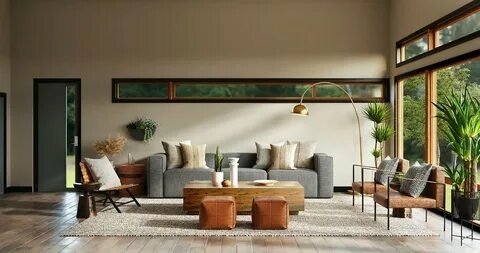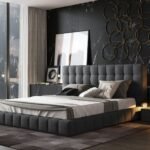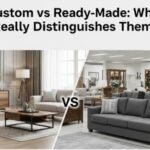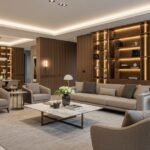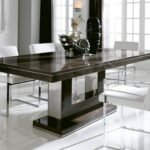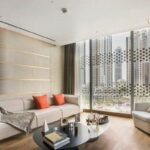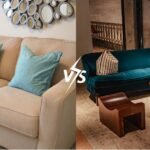5 Must-Follow Interior Design Trends That Will Shape Your Spaces
Interior design has evolved from mere decoration into a powerful means of enhancing comfort, productivity, and emotional well-being. As our lives become more connected and fast-paced, the spaces we inhabit whether at home or in the workplace must offer both functionality and sanctuary. The latest trends in interior design are a reflection of this shift, embracing warmth, character, and mindfulness.

In 2025, design is less about rigid rules and more about storytelling. Spaces are becoming deeply personal, sustainable, and expressive. From curved furniture to earthy tones and sculptural lighting, the following trends are defining how we shape the environments that matter most to us.
Natural Materials That Connect Us to the Earth
Natural materials are not just beautiful; they are emotionally grounding. The use of raw wood, stone, linen, clay, and rattan introduces a sense of authenticity and balance. These materials aren’t just aesthetic; they are tactile, invoking a comforting sensory experience. A wood-paneled wall, a stone basin, or a handwoven rug can completely change the feel of a room, creating warmth and connection.
Designers are blending rustic and refined elements to avoid the space feeling too primitive or too polished. Whether it’s reclaimed oak used for shelving or handmade terracotta tiles, these touches are timeless and align with the growing movement toward eco-conscious living.
Sculptural Lighting That Becomes the Focal Point
Lighting has taken a dramatic turn in modern interiors. Once considered a functional afterthought, it is now used to define a space’s personality. Statement lighting such as large pendants, asymmetrical chandeliers, and abstract sconces is playing a dual role of art and illumination. These lighting pieces don’t just light up a room; they elevate its entire character.
This trend embraces creativity and innovation, with designers experimenting with blown glass, metal mesh, and sustainable materials. Layered lighting, combining ambient, task, and accent sources, is also becoming essential to achieving a balanced, versatile space that adapts to different moods and activities throughout the day.
Curves, Arches, and Flowing Forms
Say goodbye to sharp angles and harsh lines. Interior design is entering a softer era, where curves and organic shapes dominate. Curved sofas, rounded coffee tables, and arched entryways are not just visually soothing—they also promote a sense of calm and inclusiveness.
These shapes are deeply human, echoing the natural world and the human form. They bring fluidity into a space, making it feel more nurturing and less mechanical. Even when used sparingly, curves can offset the rigidity of a boxy room or complement a minimalist palette, adding an element of surprise and softness.
Warm Earth Tones and Layered Neutrals
Colors have a psychological impact, and the design world is embracing earthy hues that evoke comfort, warmth, and groundedness. Shades like clay, olive, ochre, and soft terracotta are dominating walls, furniture, and textiles. These colors aren’t loud they’re rich in depth and texture.
Designers are increasingly turning to paint techniques like limewash and plaster finishes to add an aged, lived-in feeling to new interiors. When combined with layered neutrals like warm beige, taupe, or ivory, the result is a space that feels welcoming and organic. This color direction supports mental wellness by reducing visual noise and fostering tranquility.
Sustainable, Purpose-Driven Design
Perhaps the most important trend shaping interiors is the emphasis on sustainability. Conscious design is no longer an option it’s a responsibility. Homeowners are thinking long-term and investing in furniture, materials, and décor that are durable, recyclable, or responsibly sourced.
From choosing non-toxic paints to restoring vintage furniture, every element is now a conscious decision. This also includes selecting pieces with story and soul items that reflect artisan craftsmanship or cultural heritage. The goal is not just to decorate, but to create meaningful, lasting spaces that are aligned with one’s values.
Best Techniques to Use These Trends
Although it’s enticing to pursue trends, the best places are those that seem natural and deliberate. Using your needs and lifestyle, pick trends with care. If you, for instance, work from home, give comfort and natural light front priority. Select earthy hues and curves to foster a relaxing setting for intense concentration.
Include natural materials in high-touch surfaces including seating, countertops, and flooring. Let statement lighting guide the design in important spots such the living room or dining area. Layer textures and neutral tones to create a pleasant and welcoming inside; don’t be afraid.
Particularly if your home is smaller, concentrate on developing flexible, adaptable designs. And keep in mind that quality comes before numbers. Invest in less, better things that have many uses and age beautifully.
Frequently Asked Questions (FAQ)
Q: What is the most significant design trend within the present?
A: The most powerful trend across all facets of interior design is maybe sustainability. Over quick, throwaway decoration, designers and homeowners are giving more emphasis to sustainable materials, ethical production, and long-term value. This tendency affects not just what we place in our houses but also how we view the lifetime of every item.
Q: On a shoestring, how could I include these trends?
A: Staying current doesn’t call for a total house makeover. Begin modest: add curved lamp or earthy-toned cushions. For unusual items, think about second hand or vintage shops. With little cost, painting a wall in a warm, neutral color or putting up a sculptural lighting fixture can totally revitalize a room.
Q: Must I adhere to every trend to have a fashionable home?
A: Not really. The best-planned spaces are those that satisfy your practical demands and mirror your personality. Trends are guides, not laws. Select what appeals to you then incorporate it with classic components for a room that feels new yet lasts.
Q: Are curves and arches merely a trend?
A: Curves have long historical roots and psychologic charm. They appeal to basic human desires for comfort and security rather than just being fashionable. Including curves into your house can provide enduring warmth and personality whether they keep a prevailing trend or not.
Q: Can sustainable design yet be opulent?
A: Absolutely. Actually, the workmanship, materials, and careful design of sustainable interiors frequently give off a more opulent air. Handcrafted furniture, natural finishes, and creative elements can give a room way beyond mass-produced options.
Last thoughts: Deliberate Design
Interior design is about intention, not about perfection. The patterns molding 2025 show a rising consciousness of how our surroundings affect our mood, health, and behavior. The need for cozy, true, and significant design grows even more as we spend more time in our homes and places of employment.
With the five trends described above, you may design timeless, soulful interior. Combining natural materials, sculptural lighting, soft shapes, warm colors, and sustainable methods will help you to create a place that feels right as well as looks lovely.
Design is a trip rather than a destination. Let these trends help you toward a place that represents your values and improves your everyday life whether you are redecorating a room or starting from scratch. Your house can transform into a haven that helps you to be at your best with deliberation, originality, and attention.
